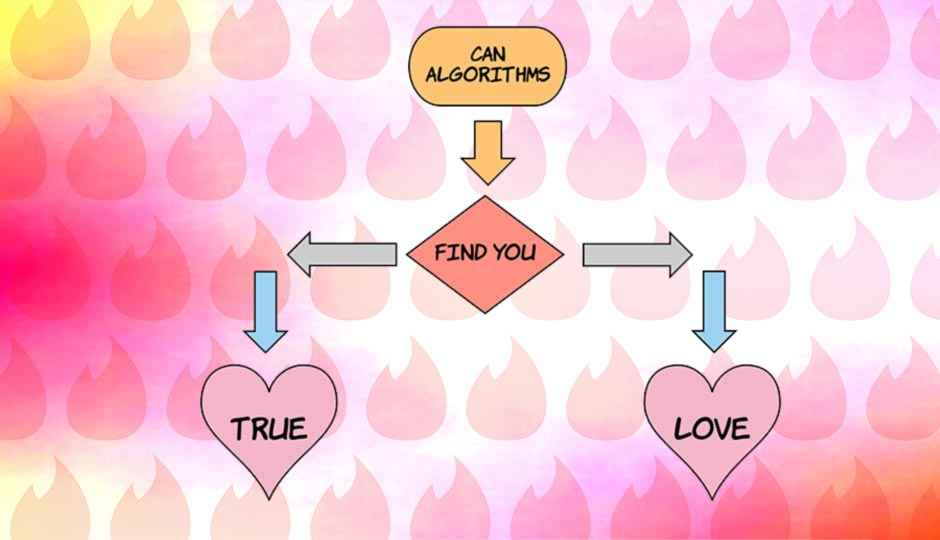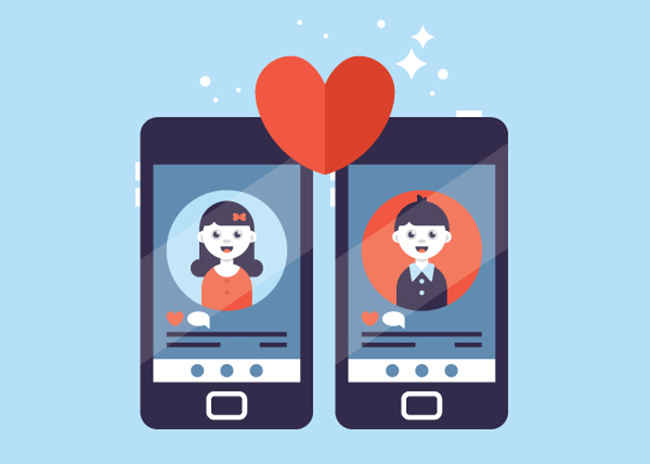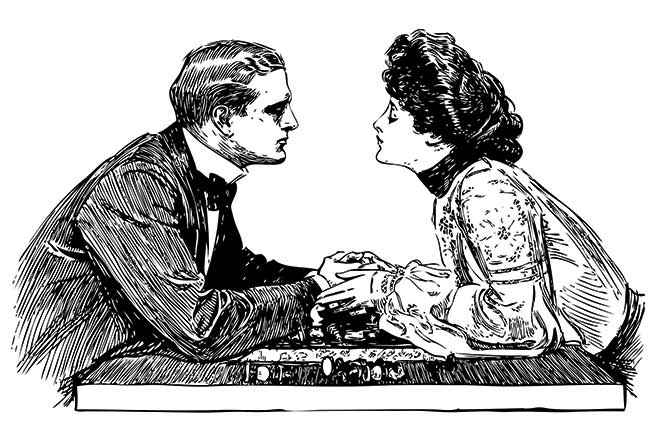The truth about dating algorithms

Advanced cloud-based algorithms promise to find you the perfect match, but can machines really understand emotion enough to make that call?
Technology exists to make our lives easier, and socialising is definitely a major part of your life. Between 2005 and 2016, a little less than half of the couples that got married in the United States had met online. Unless you’ve been living in North Korea, you know what online dating is, and unless you’ve been in a relationship since the ’90s, you’ve tried it too. With more than 1.5 billion daily swipes on Tinder, chances are high that your relationship was a match made in the cloud. But can a machine really find you love?

Love at first swipe
Dating Online
Dating applications and matrimonial sites are like a bar, or the mall – they offer you the opportunity of a common space to bump into someone interesting. You might like that person or eventually fall in love, or you could not want to see them after the first meeting. Playing matchmaker is hard, and technology has to work overtime to try and ensure a better fit. Some services such as OkCupid show compatibility percentages, where you can see each others’ answers after matching. Others like Tinder are less meticulous in their match-making and more like a classified ads community. But how do match-making algorithms work?
Match-making is modeled as finding optimal relationships between people (users) given their characteristics and preferences. For this, the system/machine needs to convert people into mathematical data. This data collection is usually done by gathering details through common auto-authentication accounts such as Facebook or Google. Then that data is enhanced, usually by using a detailed questionnaire. The questions are designed to measure various personality vectors that are proprietary to each company. Personalities are then tested for compatibility subjecting this multidimensional data to relevant queries (running the algorithm).
Now every company will have their own way of trying to be more accurate, but the basic method is pretty much the same. The biggest flaw of this system is that the information entered is usually wrong. The problem with us humans is that we perceive ourselves to be something we’re usually not. When self-reporting, we are biased. We provide data about who we think we are, or often who we would like to be. We over- or under-estimate different aspects of our personalities, and too often we just give the answers we think a potential match would want to see.
Add in the complexity of humans and how we cannot all be fitted into neat little categories (no matter how hard the companies try), and you end up with a really bad description of the “real you” in a dating website’s dataset. The only leveler might be that your potential match’s data is probably just as bad a descriptor of them, so you could still potentially hit it off!
OkCupid tries to solve for this by asking questions like “Do you like to discuss politics with your partner?” or “Are you annoying?”. The only truthful answer to this is “It depends”, but how many people will say that?
Thank Algorithms we’re together!
The first time computer algorithms were used to match people was back in 1965, when computers still used punch cards. Jeff Tarr, then a mathematics student at Harvard, gave out questionnaires for people to describe their “ideal date”. The information was then processed in an IBM-1401 according to his algorithm and six suggestions were spit out for a given person (which was then mailed to them. Each of the six suggestions also got the given person’s contacts along with that of five others. It turned out to be a success and a year later Tarr boasted about having received over 90,000 applications for Operation Match. Even then, there was something about the aura of a match making machine that attracted people who bestowed a special faith in the decisions of this machine.
We have come a long way since then, in terms of the mathematics of the algorithms as well as the basis of the questionnaires. Academic style observation certainly helps. eHarmony’s algorithm was the first to be based on scientifically conducted research (by psychologist Neil Clark Warren, who collected over 3 years of data from 5,000 couples). It’s a self-fulfilling cycle from then on, as more user data leads to better matches and hence more users, and so on. For the other category of dating apps that don’t suggest matches, the mathematics is purely based on a one-is-to-one profile assessment and if it is a two way approval, users are matched. After the category and some metadata is specified, the onus is on the user to discriminate between choices. This system is easily gamed, however.
Chris McKinlay, a math student at UCLA, managed to group categories of OkCupid’s user base and figure out how the algorithms match amongst them. Then he adjusted his profile according to the two groups he wanted to match with, and voila! There were 10-12 girls texting him every day. He owned their system, and went on a dating spree, a year before he married his 88th date. All that math and it still took him 87 wrong answers to get to the right one…
Another way algorithms have evolved is their efficient use of the exabytes of data that all of us create. In 2007, Gavin Potter gained unconventional success while competing in the $1 million Netflix Prize. The aim was to enhance the quality of suggestions that Netflix recommends to its users, and Potter’s method worked more consistently than anyone else’s. What’s interesting is that while most competitors used data like the content of the user’s current likes, Gavin’s method used the user’s past preferences to predict their future behaviour based on similarities with other users who exhibited similar preferences. This technique was further developed into collaborative filtering. Gavin Potter, along with Nick Tsinonis, then founded RecSys, which now provides over 100 million personalised recommendations daily to various clients who outsource their data to the RecSys engine. Among their clients are publication giants Nature, who use it for search suggestions, and of course, many match-making websites. There’s even whitelabeldating.com, a website that helps you start your own dating service, in case you have the branding but lack the execution. As far as the efficiency of the algorithm for match-making goes, the algorithm still depends on the flawed dataset built using questions. That said, algorithms are constantly evolving, and soon, based on data from your social behaviour over time, they will know you better than you know yourself.
Mental match
Tinder recently revealed some statistics about its user base in India, and it turns out it’s increasing rapidly. What’s more, they revealed that women send out more super-likes than men. While we cannot say if the trend is replicated on all platforms, it is possible that meeting people online could be empowering for women. A place to let their hair down perhaps. Online dating is safer too, since most reputable services have additional algorithms to detect and remove fake profiles. If you are ultra-concerned about your safety then you can always take a premium subscription from a reputed provider. Although, even that won’t protect you from the occasional, self-destructive psychopath, it’s really no more of a risk than you would face offline as well.
The best thing about dating apps is that both people get to control the flow – which is to say that you only meet when both agree, phone numbers are shared at your discretion, and there’s an overall feel of being in control, for both people. Another huge advantage is that you aren’t tied down to your existing friend circle, or friends of friends. It’s exciting to meet someone totally new, who may come with totally fresh perspectives than what you’re used to. Add to that the very important convenience of it not being awkward if it doesn’t work out. Too many times people have ruined friendships because friends who introduced the two of you find themselves torn and having to take sides if it doesn’t work out.
Then there’s the ability to lower your inhibitions when meeting people who don’t know your family or close friends. Many feel that they are only able to be honest with total strangers, because there is no fear of judgement if it doesn’t work out.
People also seem to love texting, as it helps them be themselves, and avoid paralysing or awkward situations when they’re tongue-tied. Of course, sometimes it turns out that a person can only communicate in texts and not in person, and that’s hardly desirable.
Dating sites are especially beneficial to those looking for long term partners. While that may sound counter-intuitive, hear us out. With a dating site you get to meet a few people and you get to figure out certain aspects of compatibility that you didn’t know you needed before. The advantage is that on a dating website you’re not turning people down from marriage, like on a matrimonial site, instead, you’re just moving on to the next date, but the learnings can sharpen the picture you have in your head of the perfect life partner.
A profile picture like this is a x100 match boost, one with your dog will give you x50
THE PERFECT MATCH
Machine learning-based algorithms that work on big data are amazing. From global market trades to security surveillance, algorithms pretty much rule the world. They see the bigger picture on a level no human even can, and have the ability to evolve according to the needs of their creators. Take for example, the algorithms behind Spotify’s suggestions, or Facebook’s News Feed, keeping a billion plus people hooked, day in and day out, working silently and effectively. Algorithms are invading every aspect of our lives, and with good reason. But while machines are great at matching you to a product, story, picture, etc., matching people is still something they haven’t cracked just yet.
Online dating sites don’t claim that their match-making algorithms are just an alternate way to meeting people, they claim it’s a better way. Now this might be true for people who have, say, moved to a new city and don’t have too many friends or an established work/friends circle. It’s probably also true for people who are a little shy, or introverted, or suffers from social anxiety, because it gives them the ability to converse online instead of in person, at least initially. But how can a data query know what issues will rise between people in the future, how they will confront them, and how they will mature and grow? While the collaborative filtering method and other machine learning algorithms have their merits, technology cannot predict the future of people the way it can predict numbers. Besides, there are a host of collectively unanswerable questions about human relationships – do opposites really attract, or do people need to be similar? If they are too similar, won’t they get bored? If they are too different, where is their common ground? It is all very confusing and there are no right answers. Perhaps your best bet is to meet people while doing something you love. Chances are much higher that you will share a longer and more fulfilling journey through life with someone who you have an activity in common with.
As much as we’d like to believe that technology already has the answers for most things, we haven’t been able to break down a human into math just yet. How do we know this? Because if we could do that, we’d already have AI, and we don’t. The day we can fall in love with Siri or Cortana, or some other artificial consciousness (we, as in normal people, not the crazies who might already have fallen for them), that’s the day we might be able to build a case for machines truly understanding what it is to be human. Maybe then an AI algorithm would be able to act like your friends who know you well, and recommend you meet this person who they are sure you will hit it off with.
Until then, rest assured that you’re going to have to do all of the decision-making yourself, and you’re going to have to do some real work before you find love. At best, apps and algorithms can help you weed out the most obvious incompatibilities, which is still better than nothing!
Just remember, you could find love just about anywhere… online, on OkCupid or Shaadi.com, Quora or 9gag, Facebook or Twitter, at a work conference, or in a line to buy food, or, our favourite, at a bookstore, while buying your favourite computer magazine. “You love Digit too?”, has got to be the best ice breaker we’ve ever heard!
This article was first published in February 2017 issue of Digit magazine. To read Digit's articles first, subscribe here or download the Digit e-magazine app for Android and iOS. You could also buy Digit's previous issues here.






